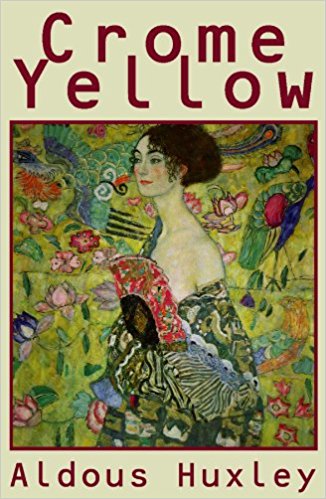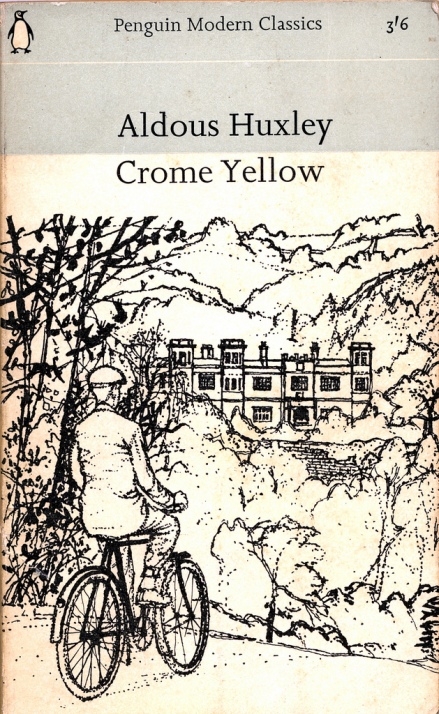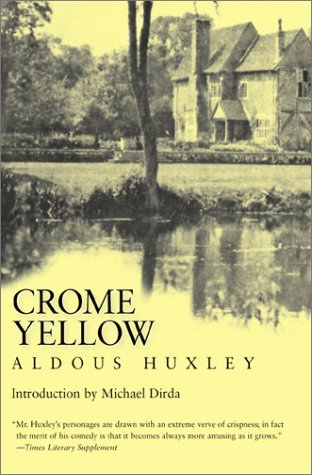Novel * Aldous Huxley * Everyone Continues to be the Worst * 1921
The Waste Land Project is a real dumb thing I’m attempting, and this is the fourth part! You can read all about the dumb thing in the first part.
Synopsis
Before we get going on my boy Aldous’ first novel, I will hereby admit that I skipped ahead in the project a little bit. Here’s my problem, and it is a serious one: I need to read The Bible. Like, all of it. Probably the King James edition, since that’s generally accepted to be the literary standard. The original plan was to address each and every reference in The Waste Land as they appear in the text. I knew Biblical references were going to happen, early and often, but I figured I’d just read the book each reference belonged to. Then a couple of things happened. After I began the project, I started thinking about the actual reason I’m doing this, which is to bolster my literary education by reading obvious things I was able to skip in pursuit of a modern education. Like, you can get a doctorate in English without reading the Bible or Homer or Virgil, y’all. Anyway, I eventually decided that only reading a book or two of the Bible was not really in line with the spirit of the project. Then, I read and enjoyed The Source, which fully underscored the fact that I am woefully inadequate when it comes to religious education. Therefore, I need to read the whole damn thing. Guess what sounds like a dreadful experience? Reading the whole damn thing. So what I’m going to do is carry on with the Waste Land Project while I take my time and read the Bible. I don’t have it in me to do it all at once, but eventually I’ll get there. Oh, and while I was at it I skipped two Wagner references in a row, but I’ll circle back next time. I just didn’t feel like listening to a four hour opera, ya know?
Right, so let’s talk about this book, Crome Yellow, and its place in The Waste Land real quick. First of all, it’s only probable that Eliot was actually referencing this novel in his poem. He didn’t include Huxley’s novel in his own notes, it was only brought to my attention in the annotated version I’m using. This is probable for a couple of reasons. The first is that they were contemporaries and moved in the same circles. Crome Yellow was published a year before Eliot published his landmark poem, and is quite frankly a slight work in comparison to what Eliot achieved with The Waste Land. The other reason is that the reference is a minor thing, in which Eliot needs a name for his Tarot-slinging fortune teller and uses the same name as Huxley’s character, Madame Sesostris. This is an unlikely coincidence, and considering the role of the Tarot in Eliot’s poem, it makes sense that he would use the name of a fictional fake invented by his contemporary. That said, a cursory search showed that Eliot regarded Huxley less than seriously. By which I mean he said that Huxley is “the sort of writer who must produce thirty bad novels before he arrives at the good one.” That’s a pretty sick burn by a guy who lifted a name and/or concept from what he presumably considered a bad novel. Not to leave Huxley hanging, he once referred to Eliot as “the most bank-clerky of all bank clerks,” so the man could hold his own in the burn unit.

What’s this book about? I dunno here’s a lady.
Leaving literary bitch-fights aside, let’s take a look at the actual novel under consideration here. As I mentioned above Crome Yellow is Aldous Huxley’s first novel. You can tell. Not to side too much with Eliot here, but it’s clear that this book is no Point Counter Point. That kind of thing takes some working up to. Not everyone can come out swinging with the likes of “The Love Song of J. Alfred Prufrock,” you know? The novel is a short one, and it has no real plot to speak of. This is not a book where things happen, rather it’s a book where characters mill around and argue with each other. Actually, “argue” is a strong term for the mild conversations happening here. Also, “character” might be too strong a term for the people populating Crome Yellow – which is the name of both the book and the manor where these folks are hanging out.
That’s all they do, by the way. They hang out. They bullshit each other and ponder the meaning of being an artist. The novel begins with a young man named Denis, who sucks. Look, this is Aldous Huxley, the man has never written a likeable character in his life. Anyway, the flavor of Denis’ suckage is that of the overly-serious-know-it-all. He’s myopic and obnoxious and everything he says sounds like it belongs in r/iamverysmart. Denis has a massive crush on Anne, who while airy and pretty is not exactly a Modern Woman. Anne doesn’t say or do much, seems mostly disconnected from the happenings within the house, enjoys dancing and the occasional lark, but is nowhere near Lady Brett or Lucy Tantamount levels of drinking and fucking. In addition to these two, there is a painter and a journalist, a couple of older gentlemen, and the lady patron of the house. They all talk at each other for a couple hundred pages and are at varying levels of insufferable.

This is an illustration of the first scene where we meet Denis and all I want to do is tip his wiener ass over.
Discussion
Crome Yellow is an obvious first novel, and reads pretty much like Point Counter Point-lite. The characters here aren’t based on any notable people in the Modernist scene, the ideas presented are not fleshed out nearly as much, and the overall atmosphere is less oppressive and skews toward light satire. The whole bit with Madame Sesostris is just that, a bit. It’s a goof in which an older gentleman dresses up like an old gypsy lady and invents terrible fortunes for people. That’s it! I suppose this could be construed as commentary about the resurgence of interest in the supernatural at the time – there was a lot of instances of rich people gathering around and doing séances or whatever – but mostly it’s just a guy dressed in drag telling people about the death and horror about to descend on them. It’s kind of funny, I get why Eliot would use the name as a literary shout out to Huxley (who he clearly didn’t respect), but there’s not really much else to talk about in context of The Waste Land.
Honestly, there’s not much to talk about in terms of the novel either. It’s an interesting document in that Huxley goes on and uses ideas first sketched out here. There’s a brief section where one of the characters (and they’re so bland and undifferentiated that I cannot remember who it is) gives a quick speech about his vision for the future. This vision is essentially an outline for the concepts behind Brave New World. He’s talking about eugenics and talking about a glorious future where the best people are specifically bred to lead society and where the lower classes are bred to be happy about their industrious lot in life and yeah, Huxley put that conversation on the shelf for ten years, fleshed it out, and wrote one of his two best novels about it. In Crome Yellow, the concept is an aside, and like the aforementioned Madame Sesostris, is probably a bit. Again, it’s hard to tell, although I took the time to look it up and oh hey it’s the same guy who dresses up at Madame Sesostris, so I guess that answers that.

It’s probably not a great sign that the best the cover quote can do is: “it’s amusing, eventually.”
I think my main problem with this novel is that it’s simply too slight. I don’t mean that it’s very short (although it is), I meat that nothing presented here is given much room for consideration. Characters drop heavy concepts, like the proto-Brave New World idea of a Rational State, and then the story flits away without much in the way of discussion or thought. For a ‘novel of ideas,’ there simply aren’t that many ideas. This would be fine if there was an actual story or characters here, but there are not. You’ve got Denis, an absolute little wiener, who spends the entire novel moping around after Anne and simultaneously lamenting how dumb everyone is while actively not creating anything worthwhile himself. He’s such a limp noodle that you can’t help but be annoyed by him, and again, if anything he’s a prototype character for Walter Bidlake in Point Counter Point, who also sucks but at least has some depth of character. Actually, I think that’s going to stand for my entire opinion of Crome Yellow. It’s a prototype for Point Counter Point. If you remove all the depth of thought and character from that novel, you end up with a borderline insufferable slight bit of literature that’s not sure if it wants to take itself seriously or not. At least with the benefit of hindsight, we know that it wouldn’t take Huxley thirty tries to write his good novel.

No where do I fine a reason why he titled the book “‘Crome Yellow.” That is, the country house and village is called Crome but no reference, however mysterious, is given for the second word in the title “Yellow.” One critic imagined it was a pun but then surely we would have been given a clue. Maybe the artist-character could have used a lot of chrome yellow colored oil paint. But, unless I was doing my usual stream-of-consciousness while reading the book, I didn’t notice such a clue.. Although the Internet doesn’t bring up a discussion or reason for the title Crome Yellow, there must be more speculation besides it being a “wonderfully sunny and beautiful location.”
LikeLike
Honestly, I wasn’t impressed enough with the novel to really give the title much thought. My assumption is just that the titular house is yellow. I also didn’t see any evidence for a pun, or really any further meaning at all. It happens.
LikeLike
I agree. The book, at best, was an academic experience. Something to drop at cocktail parties, as in “What did you think of his book, “Crome Yellow?” That would quickly free you up from a borish martini drinker. Too, the use or evidence of a pun indicates that somehow the pun is obvious and closely related within the text. A literary stretch for sure. But then there is poetic license.
Did I miss something? Was the house built with yellow brick? That would work, more or less. Of all the book titles that could have been chosen in this era, especially when a publisher is the one that really chooses, I still feel a bit of mystery is buried somewhere about it. Or, maybe not.
LikeLike